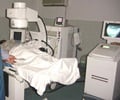
Diabetes Management in Chronic Kidney Disease
About half of patients with CKD do not have diabetes but experience high rates of kidney failure and early death. These patients are typically treated with ACE inhibitors/ARBs, when presented with albuminuria (a sign of kidney disease in which a person has too much of the protein albumin in the urine). The SGLT2 inhibitor dapagliflozin, which is designed to lower blood sugar levels, has been shown to have kidney- and heart-protective effects in patients with CKD (with and without diabetes).‘A 50-year-old patient treated with the combination therapy may live an additional 7 years without kidney failure or death as compared to a patient not receiving these medications.’
Read More..Tweet it Now
Priya Vart, PhD (University Medical Center Groningen, in the Netherlands) and his colleagues conducted a study to estimate lifetime survival free of kidney failure for patients with albuminuric CKD without diabetes treated with the combination therapy of ACE inhibitors/ARB and SGLT2 inhibitors relative to patients not treated.Read More..
The study used estimates from clinical trials of the effect of treatment with ACE inhibitors/ARBs (ramipril/benazepril) (in 690 patients) and SGLT2 inhibitors (dapagliflozin) (in 1,398 patients) compared with placebo to derive the indirect estimate of the effect of combination therapy vs. no treatment. Using this effect, investigators estimated the treatment effect of combination therapy among patients with albuminuric CKD without diabetes in the DAPA-CKD trial (697 patients) and projected kidney failure–free and overall survival for those treated and not treated with combination therapy. The primary outcome was a composite of doubling of serum creatinine (a marker of kidney dysfunction), kidney failure, or death.
Combination therapy with ACE inhibitors/ARBs and SGLT2 inhibitors was associated with a 65% lower risk of the primary outcome compared with no treatment. For a 50-year-old-patient, the estimated survival free from the primary outcome was 17.0 years with the combination therapy and 9.6 years with no treatment with any of these agents, corresponding to a gain in event-free survival of 7.4 years. Even when assuming that the effect of combination therapy is not completely additive and that treatment adherence and efficacy may wane over time, there was a gain in event-free survival of 5.3 to 5.8 years.
“The present study provides estimates of treatment benefit expressed in extra years free from the disease or death that is easy to understand for patients, clinicians, and policy makers. This may facilitate risk communication in clinical management, increase uptake of these therapies in clinical practice, and inform decision making by policy makers and payers,” the authors wrote.
An accompanying editorial notes that the findings also provide a tool for advocacy efforts to improve access to and coverage for kidney-protective medicines, especially SGLT2 inhibitors, which are currently cost prohibitive to many.
Advertisement















